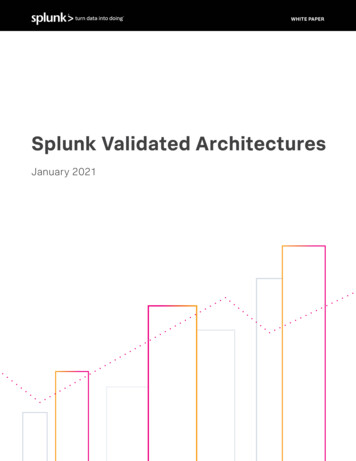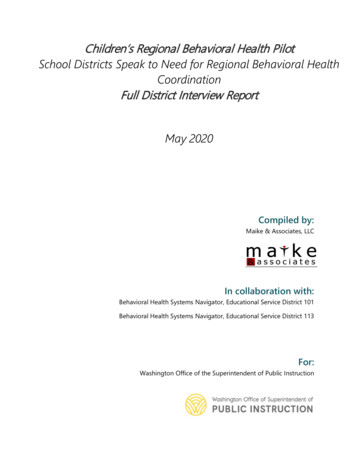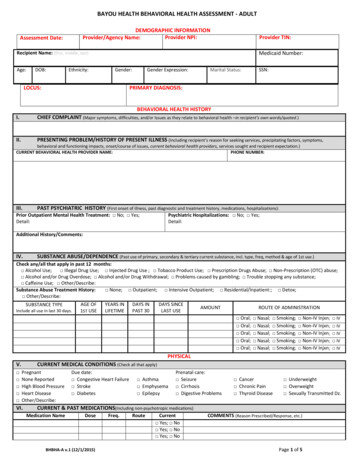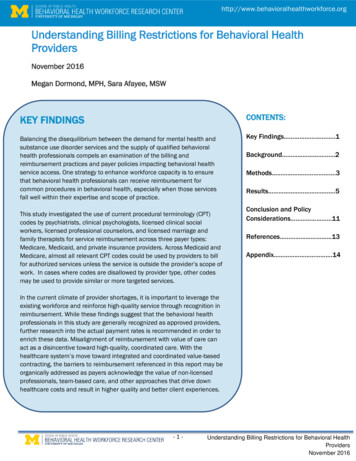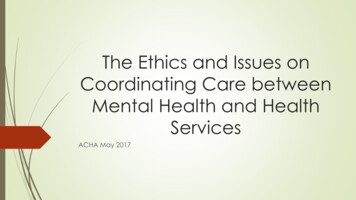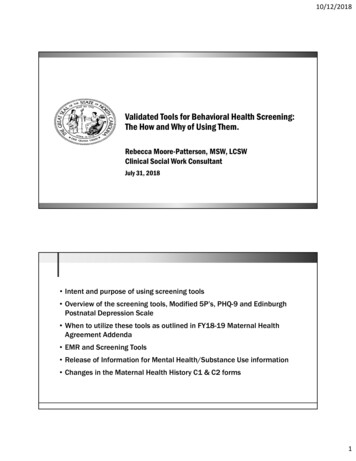
Transcription
10/12/2018Validated Tools for Behavioral Health Screening:The How and Why of Using Them.Rebecca Moore-Patterson, MSW, LCSWClinical Social Work ConsultantJuly 31, 2018 Intent and purpose of using screening tools Overview of the screening tools, Modified 5P’s, PHQ-9 and EdinburghPostnatal Depression Scale When to utilize these tools as outlined in FY18-19 Maternal HealthAgreement Addenda EMR and Screening Tools Release of Information for Mental Health/Substance Use information Changes in the Maternal Health History C1 & C2 forms1
10/12/2018 Routine screening should rely on validated screening tools.These tools have been well studied and demonstrated a highsensitivity for detecting substance use and misuse. Guidelines forPerinatal Care, 8th Edition, American Academy of Pediatrics and American College ofObstetricians and Gynecologists. Pg 137. 2017 The American College of Obstetricians and Gynecologistsrecommends that clinicians screen patients at least onceduring the perinatal period for depression and anxietysymptoms using a standardized, validated tool. ACOG CommitteeOpinion, No. 630, May 2015.Why Use a Screening Tool? Reliable Shows the same results when administered repeatedly Valid Measures what it is supposed to measure Normed Compares client’s answers to others of the same group using a largesample of people.2
10/12/2018Screening vs Assessment Screening is a process for evaluating the possibility of a substance use or mentalhealth disorder. The outcome is a simple yes or no. Assessment is a process for gathering detailed information about the nature of thedisorder and developing specific recommendations for addressing the problem ordiagnosis.Screening Tools Do Not Replace Professional JudgementYour judgement should take precedence over any results obtained.3
10/12/2018Modified 5P’s Brief Easily administered Screens for alcohol and drugs Screens for family of origin, peers and partner for alcohol anddrugsMaternal Health and High Risk MaternityAgreement Addenda FY 18-19 Local Health Departments are expected to have a policy/procedure in place regarding utilization of theModified 5P’s screening tool for prenatal & postpartum patients. Division of Public Health Agreement Addenda FY 18-19 Modified 5P’s are referenced in the Agreement Addenda in the following categories: C. Policies/Procedures C 7 (HRMC) C 11 (Maternal Health) D. Prenatal and Postpartum Services D 5 (HRMC) D 11 e (HRMC- Postpartum) D 4 (Maternal Health) D 9, e (Maternal Health Postpartum) Psychosocial Services H 2 (HRMC & Maternal Health)4
10/12/2018Risk Screening FormModified 5P’s5
10/12/2018When to Use the Modified 5P’s Initial intake If Pregnancy Risk Screening form has NOT been completed Any point during prenatal visits that professional judgementindicates Postpartum visitPHQ-9 Widely used Brief Validated and documented in a variety of populations Excellent reliability Reviews symptoms over time6
10/12/2018PHQ-9Edinburgh Postnatal Depression Scale (EDPS) Ten questions Usually completed in 5 minutes or less Validated for multiple cultures and languages High sensitivity and specificity Validated for screening for both depression and anxiety Reviews symptoms over time7
10/12/2018Edinburgh Postnatal Depression Scale (EDPS)Maternal Health and High Risk MaternityAgreement Addenda FY 18-19 Local Health Departments are expected to have a policy/procedure in place regarding screeningprenatal & postpartum patients who have a current diagnosis, symptomatic or have history ofdepression. Division of Public Health Agreement Addenda FY 18-19 The PHQ-9 and Edinburgh Postnatal Depression Scale are referenced in the Agreement Addenda in thefollowing categories: C. Policies/Procedures C 16 (HRMC) C 20 (Maternal Health) D. Prenatal and Postpartum Services D 6 (Maternal Health) D 9 c (Maternal Health- Postpartum) D 6 (HRMC) D 11 c (HRMC- Postpartum) Psychosocial Services H 1 (Maternal Health & HRMC)8
10/12/2018When to Use the PHQ-9 or EDPS Prenatal appointment At any point during prenatal visits that professional judgementindicates. A positive response is received on the Maternal Health History C 2form questions, 1 or 2 Postpartum appointmentScreening Tools and EMRThe State Archive office and the Women’s Health Branch joint consensus is: Screening tools can be incorporated into the EMR, however they must still be completed by the patient,not a healthcare professional. The patient may enter her answers on a device such as an iPad or anymethod that provides direct entry into the EMR.When a hard copy is completed: Each patient will need to complete the form. Health Departments may not use a laminated copy &wipe off the answers after the patient completes the form, use other varieties of reusable forms orenter verbal answers for the patient unless the patient can not complete the form herself due toidentified limitations. Health Departments should have a QA policy for these forms that requires an independent person (onewho did not see the Patient) to review the record entry and verify it is correct. After that verification, thedocument can then be shredded. This practice will satisfy Risk Management concerns, ensure patientsreceive care/connection they need, and keep the data print of the EMR smaller.9
10/12/2018Release of InformationRecommend LHDs include the BOLD statement in their Authorization toDisclose Form, “I understand that the information released may includesensitive information related to behavior and/or mental health, drugs andalcohol (including records of a program that provides alcohol or drug abusediagnosis, treatment, or referral, as defined by federal law at 42 C.F.R. Part 2),HIV/AIDS and other communicable diseases, and genetic testing.”orRelease of Information10
10/12/2018Changes in C1 FormChanges in C2 Form11
10/12/2018Moved to MATERNAL HEALTH HISTORY — Part AResources National Institute of Mental Health: Transforming the understanding and treatment of mental ions/postpartum-depression-facts/index.shtml National Center for Biotechnology Information: The PHQ-9 Validity of a Brief Depression Severity PMC1495268/ Guides for Perinatal Care, 9th Edition, American Academy of Pediatrics and American College of Obstetricians and Gynecologists. Pg 137. 2017 Substance Abuse Treatment: Addressing the Specific Needs of Women. Ch:4 Screening and Assessment. The National Center for BiotechnologyInformation: https://www.ncbi.nlm.nih.gov/books/NBK83253/ Bunevicius, A., Kusminskas, L., Pop, V., Pedersen, C. & Bunevicius, R. (2009). Screening for antenatal depression with the Edinburgh Depression Scale,Journal of Psychosomatic Obstetrics & Gynecology, 30(4), 238-243.12
10/12/2018ContactBecky Moore-Patterson, LCSW, MSWClinical Social Work ConsultantPhone: (919)707-5709Email: Rebecca.Moore-Patterson@dhhs.nc.gov13
Health Departments may not use a laminated copy & wipe off the answers after the patient completes the form, use other varieties of reusable forms or . A., Kusminskas, L., Pop, V., Pedersen, C. & Bunevicius, R. (2009). Screening for antenatal depression with the Edinburgh Depression Scale, Journal of Psychosomatic Obstetrics & Gynecology, 30 .

